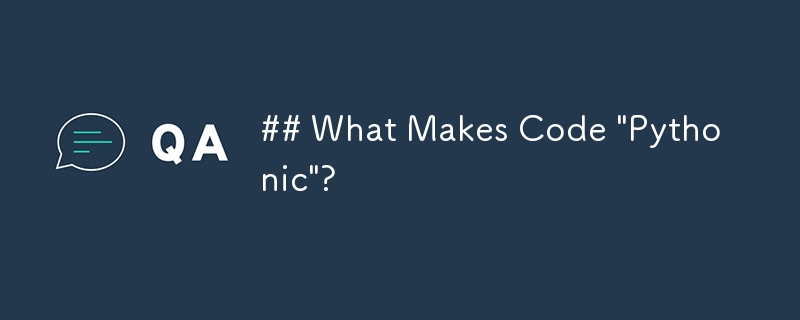## What Makes Code \'Pythonic\'?
Oct 25, 2024 am 12:51 AM
The Essence of Python: Understanding the Concept of Pythonic
Within the Python community, the term "Pythonic" frequently surfaces in code critiques, indicating a need for code optimization. So what exactly does it mean for code to be Pythonic? Essentially, it embodies the utilization of Python's unique features to craft code that excels in clarity, conciseness, and maintainability.
Pythonic code adheres to the established conventions within the Python community and leverages the language's capabilities as intended. To illustrate this concept, let's examine two code snippets:
Non-Pythonic:
<code class="python">while i < someValue:
do_something(list[i])
i += 1</code>Pythonic:
<code class="python">for x in list:
doSomething(x)</code>While the non-Pythonic example employs a traditional while loop, the Pythonic alternative opts for a for loop that iterates over the elements in the list. This approach better aligns with Python's concise and intuitive syntax.
Examples of non-Pythonic code often stem from individuals with experience in other programming languages. In an attempt to adapt familiar patterns, they may inadvertently disregard Python's intended usage. Loops, for instance, provide a prime example of this pitfall.
Consider the following code, commonly used in Java:
<code class="java">for (int index = 0; index < items.length; index++) {
items[index].performAction();
}</code>Translating this code verbatim to Python would result in a non-Pythonic approach:
<code class="python">while index < length:
items[index].perform_action()
index += 1</code>A more Pythonic solution, however, would utilize a for loop:
<code class="python">for item in items: item.perform_action()</code>
Even better, a generator expression could offer a concise and efficient alternative:
<code class="python">(item.some_attribute for item in items)</code>
In essence, when code is deemed un-Pythonic, it indicates an opportunity to enhance its compatibility with Python's coding conventions. By embracing Python's inherent capabilities, developers can create code that not only fulfills functional requirements but also embodies the elegance and simplicity that define the language.
The above is the detailed content of ## What Makes Code \'Pythonic\'?. For more information, please follow other related articles on the PHP Chinese website!

Hot Article

Hot tools Tags

Hot Article

Hot Article Tags

Notepad++7.3.1
Easy-to-use and free code editor

SublimeText3 Chinese version
Chinese version, very easy to use

Zend Studio 13.0.1
Powerful PHP integrated development environment

Dreamweaver CS6
Visual web development tools

SublimeText3 Mac version
God-level code editing software (SublimeText3)

Hot Topics
 How to Use Python to Find the Zipf Distribution of a Text File
Mar 05, 2025 am 09:58 AM
How to Use Python to Find the Zipf Distribution of a Text File
Mar 05, 2025 am 09:58 AM
How to Use Python to Find the Zipf Distribution of a Text File
 How Do I Use Beautiful Soup to Parse HTML?
Mar 10, 2025 pm 06:54 PM
How Do I Use Beautiful Soup to Parse HTML?
Mar 10, 2025 pm 06:54 PM
How Do I Use Beautiful Soup to Parse HTML?
 How to Perform Deep Learning with TensorFlow or PyTorch?
Mar 10, 2025 pm 06:52 PM
How to Perform Deep Learning with TensorFlow or PyTorch?
Mar 10, 2025 pm 06:52 PM
How to Perform Deep Learning with TensorFlow or PyTorch?
 Introduction to Parallel and Concurrent Programming in Python
Mar 03, 2025 am 10:32 AM
Introduction to Parallel and Concurrent Programming in Python
Mar 03, 2025 am 10:32 AM
Introduction to Parallel and Concurrent Programming in Python
 Serialization and Deserialization of Python Objects: Part 1
Mar 08, 2025 am 09:39 AM
Serialization and Deserialization of Python Objects: Part 1
Mar 08, 2025 am 09:39 AM
Serialization and Deserialization of Python Objects: Part 1
 How to Implement Your Own Data Structure in Python
Mar 03, 2025 am 09:28 AM
How to Implement Your Own Data Structure in Python
Mar 03, 2025 am 09:28 AM
How to Implement Your Own Data Structure in Python
 Mathematical Modules in Python: Statistics
Mar 09, 2025 am 11:40 AM
Mathematical Modules in Python: Statistics
Mar 09, 2025 am 11:40 AM
Mathematical Modules in Python: Statistics








